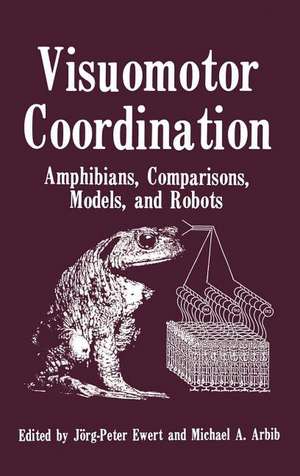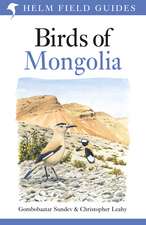Visuomotor Coordination: Amphibians, Comparisons, Models, and Robots
Autor Jorg Peter Ewert, Michael A. Arbiben Limba Engleză Hardback – 30 iun 1989
| Toate formatele și edițiile | Preț | Express |
|---|---|---|
| Paperback (1) | 1247.88 lei 6-8 săpt. | |
| Springer Us – 6 iun 2013 | 1247.88 lei 6-8 săpt. | |
| Hardback (1) | 1254.50 lei 6-8 săpt. | |
| Springer Us – 30 iun 1989 | 1254.50 lei 6-8 săpt. |
Preț: 1254.50 lei
Preț vechi: 1529.87 lei
-18% Nou
Puncte Express: 1882
Preț estimativ în valută:
240.09€ • 248.74$ • 200.36£
240.09€ • 248.74$ • 200.36£
Carte tipărită la comandă
Livrare economică 21 martie-04 aprilie
Preluare comenzi: 021 569.72.76
Specificații
ISBN-13: 9780306432309
ISBN-10: 0306432307
Pagini: 923
Ilustrații: XXXI, 923 p.
Greutate: 1.5 kg
Ediția:1989
Editura: Springer Us
Colecția Springer
Locul publicării:New York, NY, United States
ISBN-10: 0306432307
Pagini: 923
Ilustrații: XXXI, 923 p.
Greutate: 1.5 kg
Ediția:1989
Editura: Springer Us
Colecția Springer
Locul publicării:New York, NY, United States
Public țintă
ResearchDescriere
Various brain areas of mammals can phyletically be traced back to homologous structures in amphibians. The amphibian brain may thus be regarded as a kind of "microcosm" of the highly complex primate brain, as far as certain homologous structures, sensory functions, and assigned ballistic (pre-planned and pre-pro grammed) motor and behavioral processes are concerned. A variety of fundamental operations that underlie perception, cognition, sensorimotor transformation and its modulation appear to proceed in primate's brain in a way understandable in terms of basic principles which can be investigated more easily by experiments in amphibians. We have learned that progress in the quantitative description and evaluation of these principles can be obtained with guidance from theory. Modeling - supported by simulation - is a process of transforming abstract theory derived from data into testable structures. Where empirical data are lacking or are difficult to obtain because of structural constraints, the modeler makes assumptions and approximations that, by themselves, are a source of hypotheses. If a neural model is then tied to empirical data, it can be used to predict results and hence again to become subject to experimental tests whose resulting data in tum will lead to further improvements of the model. By means of our present models of visuomotor coordination and its modulation by state-dependent inputs, we are just beginning to simulate and analyze how external information is represented within different brain structures and how these structures use these operations to control adaptive behavior.
Cuprins
I: Introduction.- Experimentation and Modeling: An Introductory Discussion.- II: An Opening Perspective.- The Release of Visual Behavior in Toads: Stages of Parallel/Hierarchical Information Processing.- Visuomotor Coordination: Neural Models and Perceptual Robotics.- III: Cellular Mechanisms in Tectum and Pretectum.- Cellular Architecture and Connectivity of the Frog’s Optic Tectum and Pretectum.- Morphological and Physiological Studies of Tectal and Pretectal Neurons in the Frog.- Toward an Identification of Neurotransmitters in the Frog’s Optic Tectum.- Retina and Optic Tectum in Amphibians: A Mathematical Model and Simulation Studies.- The T5 Base Modulator Hypothesis: A Dynamic Model of T5 Neuron Function in Toads.- IV: The Role of Visual Centers.- Compensation of Visual Background Motion in Salamanders.- Nucleus Isthmi and Optic Tectum in Frogs.- Why Cortices? Neural Networks for Visual Information Processing.- Invariances in Pattern Recognition.- Perception by Sens orimotor Coordination in Sensory Substitution for the Blind.- V: The Visuomotor Interface.- Schema Theory as a Common Language to Study Sensorimotor Coordination.- Behavior-Correlated Properties of Tectal Neurons in Freely Moving Toads.- Visual Integration in Bulbar Structures of Toads: Intra/Extra-Cellular Recording and Labeling Studies.- Organization in the Sensorimotor Interface: A Case Study with Increased Resolution.- How to Transform Topographically Ordered Spatial Information into Motor Commands.- VI: Motor Control.- In Search of the Motor Pattern Generator for Snapping in Toads.- Wiping Reflex in the Frog: Movement Patterns, Receptive Fields, and Blends.- Pattern Generation for Walking Movements.- Neuroscience in Motion: The Application of Schema Theory to Mobile Robotics.- Sensorimotor Integration in Robots.- VII: Arousal, Habituation, Conditioning.- Central Representation of Arousal.- Functional Brain Circuitry Related to Arousal and Learning in Rats.- Stimulus-Specific Habituation in Toads: 2DG Studies and Lesion Experiments.- Visual Associative Learning: Searching for Behaviorally Relevant Brain Structures in Toads.- Learning and Memory in the Toad’s Prey/Predator Recognition System: A Neural Model.- Telemetric Transmission System for Single Cell Studies in Behaving Toads.- Functional Neural Systems Analyzed by Use of Interregional Correlations of Glucose Metabolism.- Neural Models, Rana and Robots.








